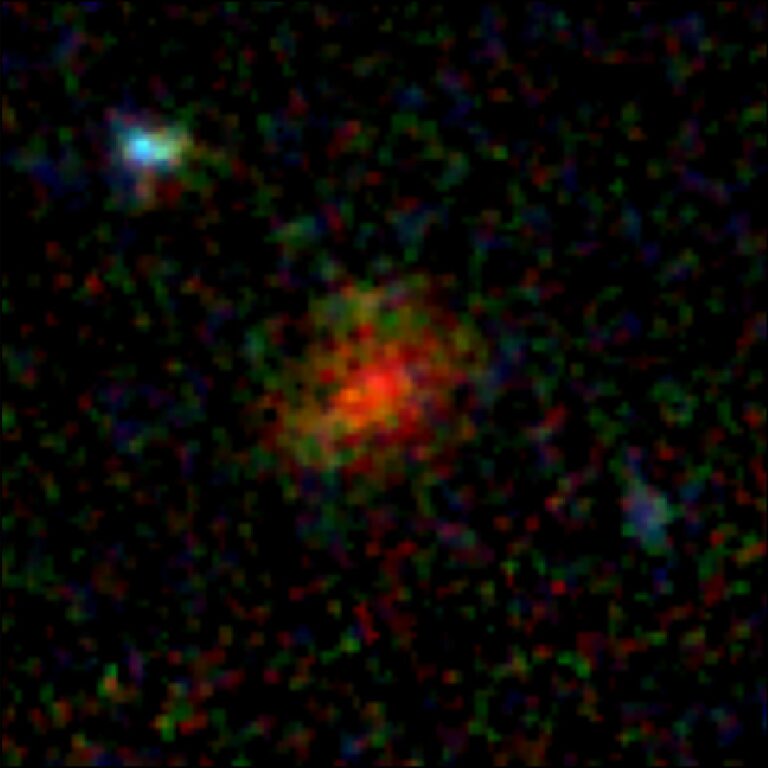Dust-veiled Galaxy Emerges Anew in Image Captured by the James Webb Space Telescope
Initially observed as a luminous anomaly through ground-based telescopes and subsequently disappearing in Hubble Space Telescope images, the ethereal entity has resurfaced in the James Webb Space Telescope (JWST) image, now manifesting as a subtle yet discernible galaxy. The collaborative efforts of astronomers within the COSMOS-Web initiative have pinpointed the enigmatic AzTECC71 as a dusty galaxy engaged in prolific star formation. These galaxies, characterized by their obscured visibility due to a dusty shroud, emerged nearly 1 billion years post-Big Bang.
Formerly believed to be exceedingly rare in the early universe, the identification of AzTECC71 and over a dozen additional candidates in the initial COSMOS-Web data, yet to be expounded in scientific literature, implies that such galaxies may be three to 10 times more prevalent than previously estimated.
Describing the discovery, Jed McKinney, a postdoctoral researcher at The University of Texas at Austin, remarked, “This thing is a real monster. Even though it looks like a little blob, it’s actually forming hundreds of new stars every year. And the fact that even something that extreme is barely visible in the most sensitive imaging from our newest telescope is so exciting to me. It’s potentially telling us there’s a whole population of galaxies that have been hiding from us.”
If substantiated, this conclusion intimates that the early universe possessed a considerably greater amount of dust than initially conjectured.
The team published its findings in The Astrophysical Journal.
The COSMOS-Web initiative, led by Caitlin Casey, an associate professor at UT Austin, and recognized as the largest inaugural research project utilizing the James Webb Space Telescope (JWST), seeks to chart the coordinates of up to 1 million galaxies within a sky area equivalent to three full moons. One of its primary objectives is to investigate the earliest formations in the universe. With a team exceeding 50 researchers, the project secured 250 hours of observing time during JWST’s inaugural year, and the initial dataset was received in December 2022, with additional data expected through January 2024.
Detecting a dusty star-forming galaxy in optical light proves challenging due to the absorption of starlight by a dust veil, subsequently re-emitted at longer wavelengths, a phenomenon referred to as “Hubble-dark galaxies” prior to the JWST era. According to Jed McKinney, a postdoctoral researcher at The University of Texas at Austin, “Until now, the only way we’ve been able to see galaxies in the early universe is from an optical perspective with Hubble. That means our understanding of the history of galaxy evolution is biased because we’re only seeing the unobscured, less dusty galaxies.”
The galaxy AzTECC71 was initially identified as a vague dust emission blob by the James Clerk Maxwell Telescope in Hawaii, operating in far-infrared to microwave wavelengths. Subsequently, the COSMOS-Web team corroborated this finding using data from the ALMA telescope in Chile, which offers higher spatial resolution and operates in the infrared spectrum. Examination of JWST data at a wavelength of 4.44 microns revealed a faint galaxy precisely in the same location. However, it remained invisible in shorter wavelengths below 2.7 microns.
Presently, the team is actively engaged in discovering more of these galaxies that exhibit faint visibility in JWST data.

McKinney emphasized, “Through the capabilities of JWST, we now have the unprecedented opportunity to examine the optical and infrared characteristics of this concealed population of galaxies, heavily veiled by dust. The telescope’s remarkable sensitivity not only allows us to peer into the farthest realms of the universe but also enables us to penetrate even the most densely shrouded cosmic dust veils.”
The research team approximates that the observed galaxy exists at a redshift of approximately 6, equivalent to around 900 million years post-Big Bang.
Contributing authors from UT Austin include McKinney, Casey, Olivia Cooper (a National Science Foundation graduate research fellow), Arianna Long (a NASA Hubble fellow), Hollis Akins, and Maximilien Franco.
This article is republished from PhysORG under a Creative Commons license. Read the original article.
Do not forget to share your opinion with us to provide you with the best posts !





0 Comments